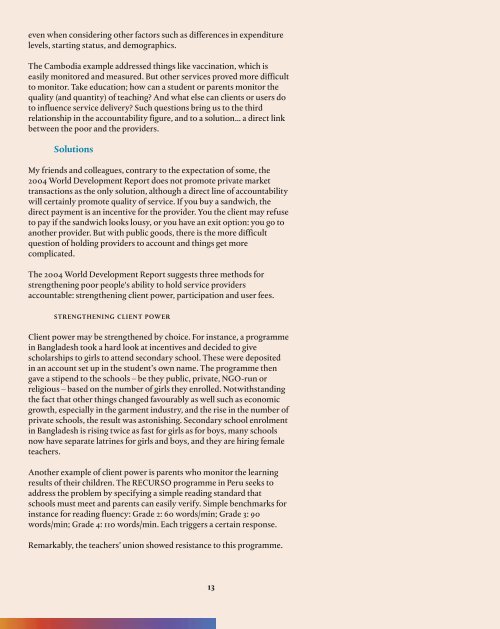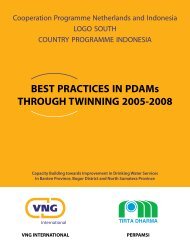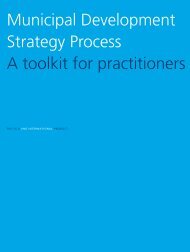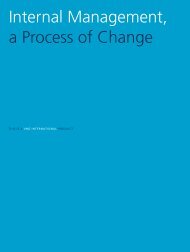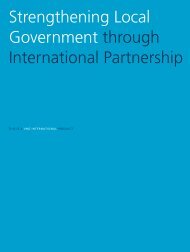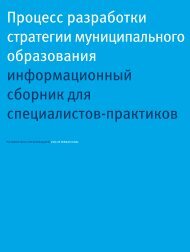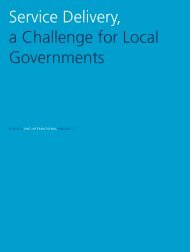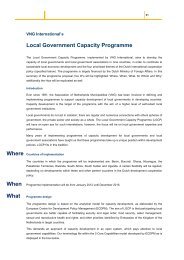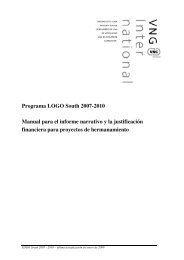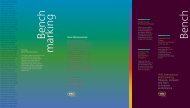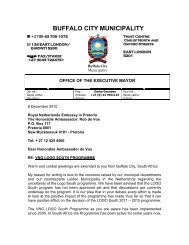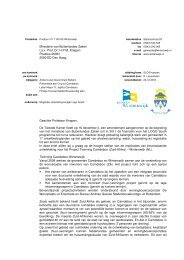Opmaak 1 - VNG International
Opmaak 1 - VNG International
Opmaak 1 - VNG International
Create successful ePaper yourself
Turn your PDF publications into a flip-book with our unique Google optimized e-Paper software.
even when considering other factors such as differences in expenditure<br />
levels, starting status, and demographics.<br />
The Cambodia example addressed things like vaccination, which is<br />
easily monitored and measured. But other services proved more difficult<br />
to monitor. Take education; how can a student or parents monitor the<br />
quality (and quantity) of teaching? And what else can clients or users do<br />
to influence service delivery? Such questions bring us to the third<br />
relationship in the accountability figure, and to a solution... a direct link<br />
between the poor and the providers.<br />
Solutions<br />
My friends and colleagues, contrary to the expectation of some, the<br />
2004 World Development Report does not promote private market<br />
transactions as the only solution, although a direct line of accountability<br />
will certainly promote quality of service. If you buy a sandwich, the<br />
direct payment is an incentive for the provider. You the client may refuse<br />
to pay if the sandwich looks lousy, or you have an exit option: you go to<br />
another provider. But with public goods, there is the more difficult<br />
question of holding providers to account and things get more<br />
complicated.<br />
The 2004 World Development Report suggests three methods for<br />
strengthening poor people's ability to hold service providers<br />
accountable: strengthening client power, participation and user fees.<br />
STRENGTHENING CLIENT POWER<br />
Client power may be strengthened by choice. For instance, a programme<br />
in Bangladesh took a hard look at incentives and decided to give<br />
scholarships to girls to attend secondary school. These were deposited<br />
in an account set up in the student’s own name. The programme then<br />
gave a stipend to the schools – be they public, private, NGO-run or<br />
religious – based on the number of girls they enrolled. Notwithstanding<br />
the fact that other things changed favourably as well such as economic<br />
growth, especially in the garment industry, and the rise in the number of<br />
private schools, the result was astonishing. Secondary school enrolment<br />
in Bangladesh is rising twice as fast for girls as for boys, many schools<br />
now have separate latrines for girls and boys, and they are hiring female<br />
teachers.<br />
Another example of client power is parents who monitor the learning<br />
results of their children. The RECURSO programme in Peru seeks to<br />
address the problem by specifying a simple reading standard that<br />
schools must meet and parents can easily verify. Simple benchmarks for<br />
instance for reading fluency: Grade 2: 60 words/min; Grade 3: 90<br />
words/min; Grade 4: 110 words/min. Each triggers a certain response.<br />
Remarkably, the teachers’ union showed resistance to this programme.<br />
13


